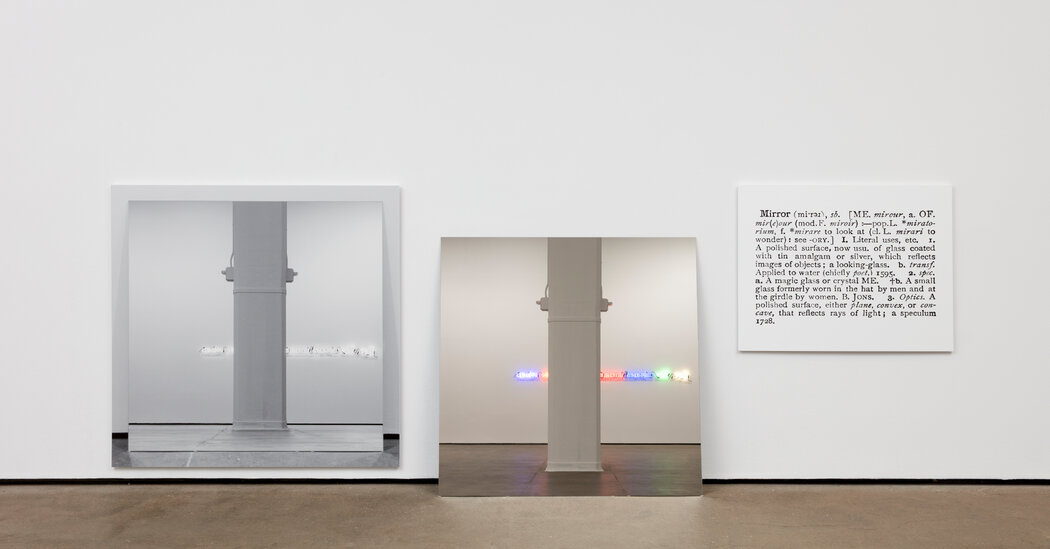It was 1965, and Joseph Cosut was a 20-year-old scholar on the Visible Arts College when he made the items that made his profession. Their prerequisite was easy sufficient: it should take an object, reminiscent of a crate, a wood door or a shovel, and both grasp it or lean it on a wall. On the one hand, it should put a photograph of this object on the identical object as put in on this place, and to the opposite, the definition of the dictionary, prolonged and printed on the poster board.
Probably the most well-known iteration is the “one and three chairs”, consisting of a chair, a photograph of a chair and the definition of a “chair”, which the Museum of Modern Artwork gained shortly after it was made. However “One and Three Mirrors” (1965), the model that appeared in his present present “,” “Future memory“The Sean Kelly gallery is even higher. It’s now as recent because the day it was made and it’s price reviewing, each due to its widespread affect on the trendy follow of artwork and since it affords as a transparent instance of the conceptual method.
Like chairs, Cosut mirrors elevate primary questions on artwork – is it an object, a picture or an thought? It’s simple sufficient to ask such questions, however they notice them in a murals, with precise objects, offers them a particular urgency as a result of they turn out to be sensible as a substitute of hypothetical. In case you are standing in entrance of 1 and three chairs, it’s important to determine what you’re looking at: Is it a chair or a chair? Doing the identical piece with a mirror that displays you, your gaze and the gallery you stand in, solely provides to the classes which can be so excitingly destabilized.
Along with a current present in Sprüth Magers in London and an upcoming exhibition of Lia room In Naples Italy, the “future reminiscence” quantities to a type of deconstructed retrospective of Cosut, which has simply been 80 years outdated. That is the primary present within the gallery that he has not designed as an entire set up and consists of work from nearly each decade of his profession, from the 60s to the current.
Seeing the entire arc uncovered on this approach, it’s simple to acknowledge each the infinite promise and the inevitable pitfalls and the lifeless of his strict method. The merger of concrete and the abstract into One and Three Mirrors is feeling as thrilling now appropriately within the 60s; If human museums nonetheless exist in a thousand years, I count on to really feel the identical. Nevertheless, his subsequent work, as he tries to improve primary questions that don’t even have solutions, turns into very slender; He basically tries to struggle the artwork in a specialised department of philosophy. (This is kind of than what he has handled in his 1969 doc. “Art after philosophyS “)
In a 1991 piece, he’s a silk screens as a quote whether or not some two issues can actually be “similar” in two adjoining items of aluminum. The observe works in the identical approach as “one and three chairs” – presents a selected instance of a philosophical problem associated to artwork in order that the viewer can suppose. The query itself merely doesn’t hit me like simply as attention-grabbing. And a few items, as when he silk screens quotes from Pihat Mondrian’s scriptures on reproductions of his work or the Gertruda Stein line, “If you are able to do it, why do it” on a large watch, to be trustworthy it is going to be higher as written descriptions. All you get by constructing them is one thing to promote.
But there’s something heroic about Cosut’s devotion all through life to the connection between thought and object, and it should be argued that his complete trajectory is a presentation in itself, one for the time, mortality and supreme uselessness of mental arguments. As Cosut himself says, within the white neon letters that cite Ludwig Wittgenstein, “Within the math and consequence, the result’s equal.”
Joseph Cosut
Till April 18. Sean Kelly, 475 10 Avenue, Manhattan; (212) 239-1181, skny.com.

